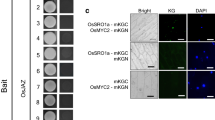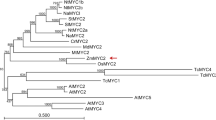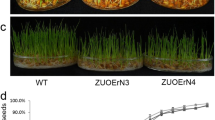Abstract
Jasmonates (JAs) are a class of phytohormones that play a crucial role in plant growth, development, and environmental stress responses. Central to JA signaling are the MYC2-type transcription factors, as they activate the expression of JA-responsive genes. We previously used CRISPR-Cas9-based genome editing to engineer rice OsMYC2 and yielded a mutant (myc2-5) with a single amino acid (aa) deletion (75I) outside the known functional domains of the protein. This myc2-5 mutant also showed some JA-deficient phenotypes, promoting us to investigate how 75I deletion affects JA responses. The mutation is found in the α2 helix element at the N-terminal of OsMYC2. The deletion of 75I in OsMYC2 rendered plants deficient in most of the JA responses, including root growth, leaf senescence, spikelet development, and resistance to pathogens and herbivores. Biochemical assays revealed that the 75I deletion markedly reduced OsMYC2 protein accumulation, subsequently diminishing its transcriptional activity. However, the deletion did not influence the protein's subcellular localization, DNA-binding capability, or its interactions with JAZ transcriptional repressors and the Mediator complex subunit MED25. Additionally, the screening of seven other deletions in the α2 helix further reinforces the importance of this protein element. Our results highlight the significance of the α2 helix in the N-terminus for OsMYC2's functionality, primarily through modulating its protein levels. This insight expands our knowledge of JA signaling and opens new avenues for research into the yet-to-be-explored domains of the MYC2 protein, with the potential to tailor JA responses in rice and other plant species.
Key message
MYC2 transcription factor is the master regulator of plant jasmonate signaling. The functional domains or elements of MYC2 protein determine its activity. Here, we identified a novel element in the N-terminus that is essential for the activity of rice MYC2.





Similar content being viewed by others
Data availability
Enquiries about data availability should be directed to the authors.
References
An C, Li L, Zhai Q, You Y, Deng L, Wu F, Chen R, Jiang H, Wang H, Chen Q, Li C (2017) Mediator subunit MED25 links the jasmonate receptor to transcriptionally active chromatin. Proc Natl Acad Sci USA 114:E8930–E8939
Baluapuri A, Wolf E, Eilers M (2020) Target gene-independent functions of MYC oncoproteins. Nat Rev Mol Cell Biol 21:255–267
Blom N, Sicheritz-Ponten T, Gupta R, Gammeltoft S, Brunak S (2004) Prediction of post-translational glycosylation and phosphorylation of proteins from the amino acid sequence. Proteomics 4:1633–1649
Cai Q, Yuan Z, Chen M, Yin C, Luo Z, Zhao X, Liang W, Hu J, Zhang D (2014) Jasmonic acid regulates spikelet development in rice. Nat Commun 5:1–13
Chen X, Liu Y-Q, Wu M-N, Yan L, Chen C-Y, Mu Y-P, Liu Y-J, Wang M-Y, Chen X-Y, Mao Y-B (2023) A highly accumulated secretory protein from cotton bollworm interacts with basic helix–loop–helix transcription factors to dampen plant defense. N Phytol 237:265–278
Chico JM, Lechner E, Fernandez-Barbero G, Canibano E, Garcia-Casado G, Manuel Franco-Zorrilla J, Hammann P, Zamarreno AM, Garcia-Mina JM, Rubioa V, Genschik P, Solano R (2020) CUL3(BPM) E3 ubiquitin ligases regulate MYC2, MYC3, and MYC4 stability and JA responses. Proc Natl Acad Sci USA 117:6205–6215
Chini A, Fonseca S, Fernandez G, Adie B, Chico JM, Lorenzo O, Garcia-Casado G, Lopez-Vidriero I, Lozano FM, Ponce MR, Micol JL, Solano R (2007) The JAZ family of repressors is the missing link in jasmonate signalling. Nature 448:666–671
Chini A, Gimenez-Ibanez S, Goossens A, Solano R (2016) Redundancy and specificity in jasmonate signalling. Curr Opin Plant Biol 33:147–156
Dathe W, Ronsch H, Preiss A, Schade W, Sembdner G, Schreiber K (1981) Endogenous plant hormones of the broad bean, Vicia fabia L. (−)-jasmonic acid, a plant-growth inhibitor in pericarp. Planta 153:530–535
Fernandez-Calvo P, Chini A, Fernandez-Barbero G, Chico J-M, Gimenez-Ibanez S, Geerinck J, Eeckhout D, Schweizer F, Godoy M, Manuel Franco-Zorrilla J, Pauwels L, Witters E, Isabel Puga M, Paz-Ares J, Goossens A, Reymond P, De Jaeger G, Solano R (2011) The Arabidopsis bHLH transcription factors MYC3 and MYC4 are targets of JAZ repressors and act additively with MYC2 in the activation of jasmonate responses. Plant Cell 23:701–715
Fonseca S, Chini A, Hamberg M, Adie B, Porzel A, Kramell R, Miersch O, Wasternack C, Solano R (2009) (+)-7-Iso-jasmonoyl-l-isoleucine is the endogenous bioactive jasmonate. Nat Chem Biol 5:344–350
Fu W, Jin G, Jimenez-Aleman GH, Wang X, Song J, Li S, Lou Y, Li R (2022) The jasmonic acid-amino acid conjugates JA-Val and JA-Leu are involved in rice resistance to herbivores. Plant Cell Environ 45:262–272
Guo H, Nolan TM, Song G, Liu S, Xie Z, Chen J, Schnable PS, Walley JW, Yin Y (2018) FERONIA receptor kinase contributes to plant immunity by suppressing jasmonic acid signaling in Arabidopsis thaliana. Curr Biol 28:3316–3324
Howe GA, Major IT, Koo AJ (2018) Modularity in jasmonate signaling for multistress resilience. Annu Rev Plant Biol 69:387–415
Hu J, Huang J, Xu H, Wang Y, Li C, Wen P, You X, Zhang X, Pan G, Li Q, Zhang H, He J, Wu H, Jiang L, Wang H, Liu Y, Wan J (2020) Rice stripe virus suppresses jasmonic acid-mediated resistance by hijacking brassinosteroid signaling pathway in rice. PLoS Pathog 16:e1008801
Jin G, Qi J, Zu H, Liu S, Gershenzon J, Lou Y, Baldwin IT, Li R (2023) Jasmonate-mediated gibberellin catabolism constrains growth during herbivore attack in rice. Plant Cell 35:3828–3844
Jung C, Zhao P, Seo JS, Mitsuda N, Deng S, Chua N-H (2015) PLANT U-BOX PROTEIN10 regulates MYC2 stability in Arabidopsis. Plant Cell 27:2016–2031
Kazan K, Manners JM (2013) MYC2: the master in action. Mol Plant 6:686–703
Li R, Weldegergis BT, Li J, Jung C, Qu J, Sun Y, Qian H, Tee C, van Loon JJA, Dicke M, Chua N-H, Liu S-S, Ye J (2014) Virulence factors of Geminivirus interact with MYC2 to subvert plant resistance and promote vector performance. Plant Cell 26:4991–5008
Li T, Yang S, Kang X, Lei W, Qiao K, Zhang D, Lin H (2019) The bHLH transcription factor gene AtUPB1 regulates growth by mediating cell cycle progression in Arabidopsis. Biochem Biophys Res Co 518:565–572
Lian T-F, Xu Y-P, Li L-F, Su X-D (2017) Crystal structure of tetrameric Arabidopsis MYC2 reveals the mechanism of enhanced interaction with DNA. Cell Rep 19:1334–1342
Liu M, Hong G, Li H, Bing X, Chen Y, Jing X, Gershenzon J, Lou Y, Baldwin IT, Li R (2023) Sakuranetin protects rice from brown planthopper attack by depleting its beneficial endosymbionts. Proc Natl Acad Sci USA 120:e2305007120
Lorenzo O, Chico JM, Sanchez-Serrano JJ, Solano R (2004) Jasmonate-insensitive1 encodes a MYC transcription factor essential to discriminate between different jasmonate-regulated defense responses in Arabidopsis. Plant Cell 16:1938–1950
Major IT, Yoshida Y, Campos ML, Kapali G, Xin X-F, Sugimoto K, de Ferreira, DO, He SY, Howe GA (2017) Regulation of growth-defense balance by the JASMONATE ZIM-DOMAIN (JAZ)-MYC transcriptional module. N Phytol 215:1533–1547
Pauwels L, Barbero GF, Geerinck J, Tilleman S, Grunewald W, Perez AC, Chico JM, Vanden Bossche R, Sewell J, Gil E, Garcia-Casado G, Witters E, Inze D, Long JA, De Jaeger G, Solano R, Goossens A (2010) NINJA connects the co-repressor TOPLESS to jasmonate signalling. Nature 464:788–791
Sethi V, Raghuram B, Sinha AK, Chattopadhyay S (2014) A mitogen-activated protein kinase cascade module, MKK3-MPK6 and MYC2, is involved in blue light-mediated seedling development in Arabidopsis. Plant Cell 26:3343–3357
Sheard LB, Tan X, Mao H, Withers J, Ben-Nissan G, Hinds TR, Kobayashi Y, Hsu F-F, Sharon M, Browse J, He SY, Rizo J, Howe GA, Zheng N (2010) Jasmonate perception by inositol-phosphate-potentiated COI1-JAZ co-receptor. Nature 468:400–405
Shin J, Heidrich K, Sanchez-Villarreal A, Parker JE, Davis SJ (2012) TIME FOR COFFEE represses accumulation of the MYC2 transcription factor to provide time-of-day regulation of jasmonate signaling in Arabidopsis. Plant Cell 24:2470–2482
Shyu C, Figueroa P, DePew CL, Cooke TF, Sheard LB, Moreno JE, Katsir L, Zheng N, Browse J, Howe GA (2012) JAZ8 lacks a canonical degron and has an EAR motif that mediates transcriptional repression of jasmonate responses in Arabidopsis. Plant Cell 24:536–550
Stitz M, Hartl M, Baldwin IT, Gaquerel E (2014) Jasmonoyl-l-isoleucine coordinates metabolic networks required for anthesis and floral attractant emission in wild tobacco (Nicotiana attenuata). Plant Cell 26:3964–3983
Thines B, Katsir L, Melotto M, Niu Y, Mandaokar A, Liu G, Nomura K, He SY, Howe GA, Browse J (2007) JAZ repressor proteins are targets of the SCFCO11 complex during jasmonate signalling. Nature 448:661–665
Ueda J, Kato J (1980) Isolation and identification of a senescence-promoting substance from wormwood (Artemisia absinthium L). Plant Physiol 66:246–249
Wang G, Hu C, Zhou J, Liu Y, Cai J, Pan C, Wang Y, Wu X, Shi K, Xia X, Zhou Y, Foyer CH, Yu J (2019) Systemic root–shoot signaling drives jasmonate-based root defense against nematodes. Curr Biol 29:3430–3438
Wang X, Chen Y, Liu S, Fu W, Zhuang Y, Xu J, Lou Y, Baldwin IT, Li R (2023) Functional dissection of rice jasmonate receptors involved in development and defense. N Phytol 238:2144–2158
Wasternack C, Hause B (2013) Jasmonates: biosynthesis, perception, signal transduction and action in plant stress response, growth and development. An update to the 2007 review in Annals of Botany. Ann Bot 111:1021–1058
Xie DX, Feys BF, James S, Nieto-Rostro M, Turner JG (1998) COI1: an Arabidopsis gene required for jasmonate-regulated defense and fertility. Science 280:1091–1094
Xu J, Wang X, Zu H, Zeng X, Baldwin IT, Lou Y, Li R (2021) Molecular dissection of rice phytohormone signaling involved in resistance to a piercing-sucking herbivore. N Phytol 230:1639–1652
Yan J, Li H, Li S, Yao R, Deng H, Xie Q, Xie D (2013) The Arabidopsis F-box protein CORONATINE INSENSITIVE1 is stabilized by SCFCOI1 and degraded via the 26S proteasome pathway. Plant Cell 25:486–498
Yang D-L, Yao J, Mei C-S, Tong X-H, Zeng L-J, Li Q, Xiao L-T, Sun T-P, Li J, Deng X-W, Lee CM, Thomashow MF, Yang Y, He Z, He SY (2012) Plant hormone jasmonate prioritizes defense over growth by interfering with gibberellin signaling cascade. Proc Natl Acad Sci USA 109:E1192–E1200
Yang Y, Li L, Qu L-J (2016) Plant mediator complex and its critical functions in transcription regulation. J Integr Plant Biol 58:106–118
You X, Zhu S, Zhang W, Zhang J, Wang C, Jing R, Chen W, Wu H, Cai Y, Feng Z, Hu J, Yan H, Kong F, Zhang H, Zheng M, Ren Y, Lin Q, Cheng Z, Zhang X, Lei C, Jiang L, Wang H, Wan J (2019) OsPEX5 regulates rice spikelet development through modulating jasmonic acid biosynthesis. N Phytol 224:712–724
Zhai Q, Yan L, Tan D, Chen R, Sun J, Gao L, Dong M-Q, Wang Y, Li C (2013) Phosphorylation-coupled proteolysis of the transcription factor MYC2 is important for jasmonate-signaled plant immunity. PLoS Genet 9:e1003422
Zhang Y, Su J, Duan S, Ao Y, Dai J, Liu J, Wang P, Li Y, Liu B, Feng D, Wang J, Wang H (2011) A highly efficient rice green tissue protoplast system for transient gene expression and studying light/chloroplast-related processes. Plant Methods 7:30
Zhang F, Yao J, Ke J, Zhang L, Lam VQ, Xin X-F, Zhou XE, Chen J, Brunzelle J, Griffin PR, Zhou M, Xu HE, Melcher K, He SY (2015) Structural basis of JAZ repression of MYC transcription factors in jasmonate signalling. Nature 525:269–273
Zhuang Y, Wang X, Llorca LC, Lu J, Lou Y, Li R (2022) Role of jasmonate signaling in rice resistance to the leaf folder Cnaphalocrocis medinalis. Plant Mol Biol 109:6247–6637
Zhuo M, Sakuraba Y, Yanagisawa S (2020) A jasmonate-activated MYC2-Dof2.1-MYC2 transcriptional loop promotes leaf senescence in Arabidopsis. Plant Cell 32:242–262
Acknowledgements
We thank Jing Lv, Leilei Li, Xinjue Wang, Jie Xu and Xinhui Gan for technical assistance, and Jane Marczewski, Lucas Cortés Llorca for editorial assistance.
Funding
This work was supported by the State Key Laboratory for Managing Biotic and Chemical Threats to the Quality and Safety of Agro-products (Grant No. 2021DG700024-KF202324, to R.L.), a Grant from Max Planck Partner Group Program (to R.L.), and the Hundred-Talent Program of Zhejiang University (to R.L.).
Author information
Authors and Affiliations
Contributions
RL designed the research. HZ, GJ, YK, ZL and RL performed experiments. HZ, RL, and YL analyzed data. RL and HZ wrote the manuscript.
Corresponding author
Ethics declarations
Conflict of interest
The authors declare no potential conflict of interest.
Additional information
Publisher's Note
Springer Nature remains neutral with regard to jurisdictional claims in published maps and institutional affiliations.
Supplementary Information
Below is the link to the electronic supplementary material.
Rights and permissions
Springer Nature or its licensor (e.g. a society or other partner) holds exclusive rights to this article under a publishing agreement with the author(s) or other rightsholder(s); author self-archiving of the accepted manuscript version of this article is solely governed by the terms of such publishing agreement and applicable law.
About this article
Cite this article
Zu, H., Jin, G., Kong, Y. et al. The N-terminal α2 helix element is critical for the activity of the rice transcription factor MYC2. Plant Mol Biol 114, 2 (2024). https://doi.org/10.1007/s11103-023-01411-y
Received:
Accepted:
Published:
DOI: https://doi.org/10.1007/s11103-023-01411-y




